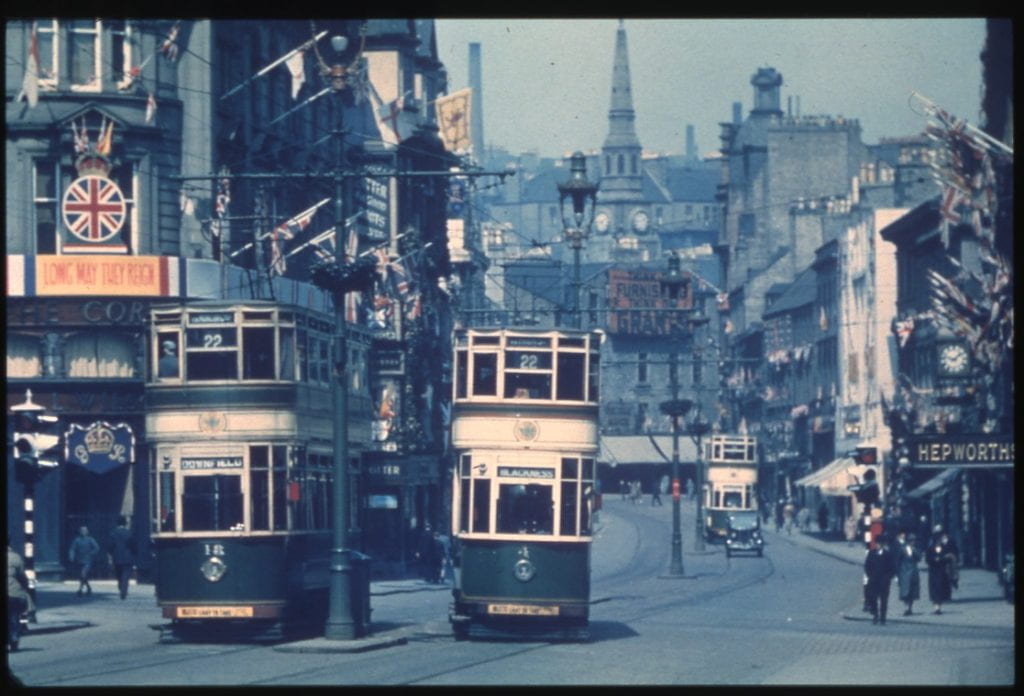The Murraygate is undoubtedly one of Dundee’s best-known streets and also one of its most historic, dating back to the medieval period. This blog by Kenneth from the University Archives takes us back in time to explore the street and its history.

As can be seen on Crawford’s map of 1776 it was one of the burgh’s main streets which spread out from the centre of the burgh. It led to the Wellgate and thence on to the main routes to the north. As such it was always a busy thoroughfare. Yet, as can be seen from the map it was very narrow in parts, particularly where it joined the High Street. As Dundee grew this became a serious problem.
In 1871 an Improvement Act was passed which aimed to tackle the poor living conditions which blighted much of central Dundee. It also provided for the construction of new roads and the widening of existing ones to ease congestion. As can be seen from these plans, significant alterations were made to central Dundee and the Murraygate was particularly impacted. The “narrows” at the High Street end were widened and the extended Commercial Street now cut through Murraygate.

This process saw the demolition of several of the street’s older buildings, many of which had become overcrowded and unsanitary as Dundee’s population ballooned. Also lost at this time was the Trades Hall, built in 1776, which had stood between the Seagate and Murraygate entrances to the High Street. The widened entrance was now flanked by the Clydesdale Bank. While it is sometimes stated that the bank stands on the site of the Trades Hall this is a myth. The Trades Hall (which was latterly used by the Clydesdale Bank) actually stood just in front of the building, and for a brief period both buildings co-existed as can be seen from contemporary photographs.

One of the most impressive parts of the redevelopment of this area was the buildings on the junctions with Commercial Street. While the rear of the Clydesdale Bank accounted for one corner, the remaining three consisted of three similar grand buildings. These would eventually be home to three of Dundee’s most successful department stores – D. M. Brown, G. L. Wison and Smith Brothers. We hope to look more at their stories and that of Dundee’s other department stores in a future blog post.


1937

The presence of the department stores contributed to the Murraygate’s status as Dundee’s main shopping street. As well as local shops, the twentieth century saw the street become the location for branches of some major national retailers. Marks and Spencer has proved to be the longest lasting of these names, having opened in 1918 and still trading today. However, it is scheduled close in the near future when a new store at the Gallagher Retail Park opens.

Other well-known names to have had major branches in Murraygate over the years include Hepworths, Burtons, Dolcis, Dixons, Goldbergs and Woolworths. John Menzies was another well-known name associated with the Murraygate. In the 1975 it moved from Whitehall Street into the former Smith Brothers building, before moving to the building formally occupied by Woolworths in the 1980s.

From the 1913 until 1965, another major attraction in the Murraygate was the La Scala cinema. Generally considered to be the first purpose-built Dundee cinema, it could seat around 1,000 people. After its closure it was acquired by Woolworths who wished to extend their premises.

The volume of shops and numbers of pedestrians using the street eventually led to its closure to traffic. This helped Murraygate to retain some distinctive features, notably being the last part of Dundee to have tramlines (which were relayed when the old cobbles in the road were replaced in the 1990s). However, the general decline in high street shopping and the pull of the Overgate Centre have hit the street hard in recent years and it may be that its future lies away from being the hub of Dundee shopping.



A fantastic little piece of history. I have often wondered about those tram tracks.